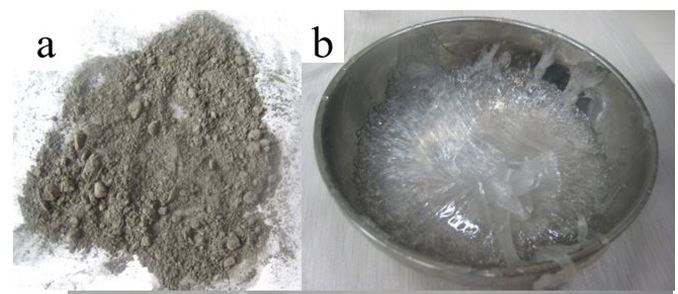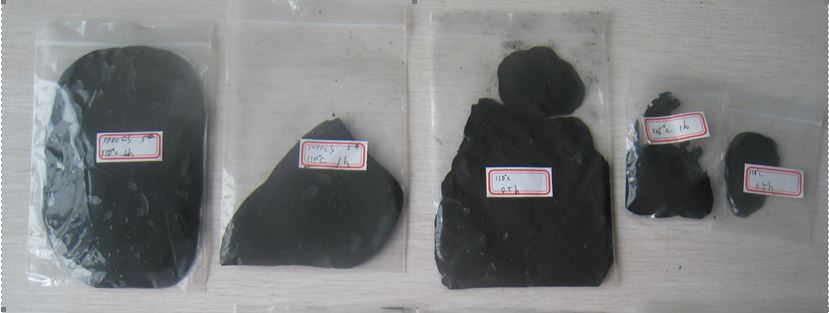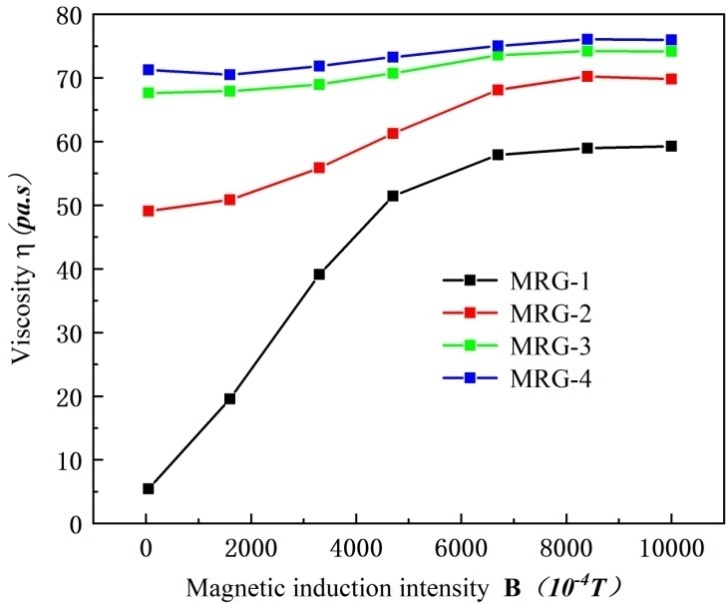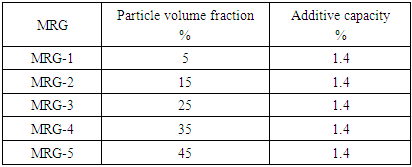-
Paper Information
- Paper Submission
-
Journal Information
- About This Journal
- Editorial Board
- Current Issue
- Archive
- Author Guidelines
- Contact Us
International Journal of Materials Engineering
p-ISSN: 2166-5389 e-ISSN: 2166-5400
2019; 9(2): 34-38
doi:10.5923/j.ijme.20190902.03

Preparation of Magnetorheological Greases and Study Their Rheological Characteristics Considering the Variety of Factors
Tiger Hu Sun, Junyu Ge, Zhihang Jia, Nan Huang
Faculty of Civil Engineering and Mechanics, Jiangsu University, Zhenjiang, China
Correspondence to: Tiger Hu Sun, Faculty of Civil Engineering and Mechanics, Jiangsu University, Zhenjiang, China.
| Email: |  |
Copyright © 2019 The Author(s). Published by Scientific & Academic Publishing.
This work is licensed under the Creative Commons Attribution International License (CC BY).
http://creativecommons.org/licenses/by/4.0/

Magnetorheological grease (MRG) is a new type of MR material, which is mainly composed of micron sized magnetic particles, basic solution and additives. Because of its low settlement rate, simple sealing structure, easy preparation and so on, it has a huge engineering application prospect. In this study, the samples of MRG with 5%, 15%, 25%, 35%, 45% carbonyl iron (CI) powder were prepared by using commercial grease as the matrix. The shear stress and viscosity of MRG with different CI powder volume fractions and the change of zero field apparent viscosity with CI powder volume fractions were measured by using a rotating rheometer and a parallel plate measuring system. The results show that the mechanical properties of MRG can be described by Bingham viscoplastic model. With the increase of magnetic induction intensity, the shear stress of MRG increases; when the shear strain rate is less than 50s-1, the shear stress of MRG increases rapidly, but when the shear strain rate is greater than 50s-1, the shear stress of MRG tends to be gentle; the apparent viscosity of MRG increases with the increase of magnetic induction intensity, at first it rises rapidly, then it tends to be stable; zero field viscosity of MRG increases with the increase of CI powder volume fractions.
Keywords: Magnetorheological Greases, Rheological Characteristics, Samples, Experimental, Magnetic Field
Cite this paper: Tiger Hu Sun, Junyu Ge, Zhihang Jia, Nan Huang, Preparation of Magnetorheological Greases and Study Their Rheological Characteristics Considering the Variety of Factors, International Journal of Materials Engineering , Vol. 9 No. 2, 2019, pp. 34-38. doi: 10.5923/j.ijme.20190902.03.
Article Outline
1. Introduction
- Magnetorheological (MR) fluid is considered as one of the intelligent and smart materials because of its adjustable rheological characteristics [1–3]. It exhibits a unique change that transforms from fluid-like state to solid-like state within milliseconds under the existence of an external magnetic field and returns to their original fluid-like state with the absence of an external magnetic field. Furthermore, this change is rapid, noticeable, and reversible. Previous studies have shown that during the dynamic phase transition, the magnetic particles form chain or cluster structures that change rheological properties of MR fluids, such as shear stress, shear yield stress, apparent viscosity, storage modulus, and so on [4-6]. Therefore, MR fluids allow widespread engineering applications including active controllable shock absorber, clutch, engine mounts, damper, sealing device and others [7–9]. Even though MR fluids have lots of merits, they have a serious sedimentation drawback caused by the density mismatch, which obstruct their extensive industrial applications [10]. Due to this sedimentation problem, various methods, such as coating polymer on magnetic particles, addition of an additive into MR fluids have been studied to reduce the density mismatch [11]. Based on these arguments, changing of a suspending medium can also give another possibility to overcome the problem, and grease becomes a strong candidate in this category [12]. Note that the suspending grease medium is a non-Newtonian fluid exhibiting a yield-stress property. By comparison with typical MR fluids, the advantage of MR grease (MRG) is the excellent dispersion stability of magnetic particles in a grease medium. Since MRG adopts grease materials as a carrier medium, the sedimentation phenomenon does not occur in the system due to the characteristic of the medium, which has the capability to disperse particles in balance against gravity [13-15]. Due to the outstanding dispersion stability characteristic of the MRG, Its advantages in industrial applications are more and more obvious, such as seismic controllable dampers which are used for provision against an earthquake. Without magnetic field, the torque performance of MRG-based is constant and it is not dependent on the operating speed, but the torque output of MRF clutch is strongly dependent on the operating speed. Especially in the application of sealing device, it can eliminate the leakage problem of MRF device after multiple use, greatly reduce the cost and prolong the service life of sealing device.Sahin et al. [16] investigated the effect of temperature on the rheological properties of the MR grease materials. In their study, the authors observed a significant effect on both apparent viscosity and yield stress. In addition, Zhang et al. [17] studied MR shear-thickening fluid prepared from nano-size silica particles suspended in ethylene glycol along with micron-size CI particles and claimed that this new type of MR fluid exhibited a high MR effect without sedimentation. Rankin et al. [18] put the ferromagnetic particles in grease with different viscosity respectively, and prepared the MRG with different zero field viscosity, it is proved by calculation that the matrix of lubricating grease will not affect the magnetorheological response while avoiding particle setting.Generally, ferromagnetic and ferromagnetic materials such as carbonyl iron (CI), iron, and iron oxide are used as magnetic particles for MR materials because they possess properties that are easily magnetized and demagnetized under external magnetic fields. In this study, among various magnetic materials, the CI is selected due to its high saturation magnetization and soft magnetic characteristic. Grease was chosen as a carrier fluid, because it is expected to improve sedimentation problem [19-20]. MRG was prepared via a simple method by mixing CI particles and commercial grease in a certain ratio. Our main focus was to examine rheological properties of the as-prepared CI based MRG via both static and dynamic test by using a rotational rheometer (MCR 300, Physica, Germany) equipped, the MR equipment (Physica MRD 180, Germany) and A 20mm diameter parallel-plate measuring system at a gap of 1mm under an applied magnetic field strength. The steady shear test was measured in the shear rate ranging from 0.01 to 200s−1. All measurements were carried out at room temperature.
2. Materials of Preparation
2.1. Micron Magnetic Particles
- Soft magnetic carbonyl iron (standard CM grade, BASF, Germany) microspherical particles were adopted as dispersed phase of the MRG system as shown in Fig.1(a). Its main properties are shown in Table 1. Commercial grease (Multiservice Grease E, Hankook Shell Oil Co., Ltd, Korea) was used as a suspending medium.
|
2.2. Base Solution
- The carrier is prepared with methyl silicone oil with a viscosity of 0.1 Pa·s and PEG-400 polyethylene glycol as shown in Fig.1(b).
 | Figure 1. (a) Carbonyl iron (CI) powder (b) Base solution PEG-400 polyethylene glycol |
2.3. Additives
- The surfactants include absolute alcohol, polyethylene glycol, oleic acid, isopropionic acid, glycerol, OP emulsifier, etc; Thixotropic agents include graphite, sodium nitrite, magnesium aluminum silicate, bentonite, organic bentonite, nano calcium carbonate, nano silicon dioxide, etc.
3. Methods of Preparation
- MRG, comprised of a suspension of soft magnetic CI microspherical particles dispersed in a grease medium, was prepared by a mechanical stirring method.In order to prevent particle agglomeration during the ball milling process, an appropriate amount of dispersant and solvent need to be added during ball milling.The main steps of MRG preparation:(1) Take 300g of carbonyl iron powder, 6g of oleic acid and 60g of anhydrous ethanol to mix, prepare 4 parts, and put them into 4 ball milling tanks of M-3SP2 double planet ball mill and stir for 5 minutes.(2) After ball milling for 3 hours, take out 610g of the mixture and put it in a DZF-6020 Vacuum drying box for drying and storage, After that, 122g mixture was taken out and dried at 5, 10, 15, 20, 30, 48 and 58 hours respectively.(3) Weigh other components according to the specified proportion, put them into the ball milling tank and stir them mechanically and evenly with DW-2-80W electric mixer, and then use B25 high shear emulsifier to disperse the mixture at high speed.(4) Using M-3SP2 ball mill to disperse the mixture, MRG can be obtained.According to the above methods, MRG samples were prepared as shown in Fig.2. The main components of MRG are shown in Table 2.
 | Figure 2. Samples of prepared MRG |
|
4. Results
4.1. Shear Stress and Magnetic Induction Intensity
- The magnetization of the magnetic particles is far from the saturation state when the external magnetic induction intensity is small, and therefore the shear stress in each of the 4 samples increases quickly with the increasing of magnetic induction intensity B and shown in Fig.3.
 | Figure 3. Relationship between shear stress and magnetic induction intensity of MRG samples with different volume fraction of CI particles |
4.2. Shear Stress and Shear Strain Rate
- One of the most important characteristics of MRG is that they exhibit the properties of viscous fluid without applying a magnetic field, but they exhibit the property of solid-like materials within a few microseconds with applying a magnetic field. Therefore, this mechanical property of MRG is often described with the Bingham’s viscoplastic model, in which the shear stress
 can be expressed as
can be expressed as | (1) |
 is the shear strain rate,
is the shear strain rate,  is the yield shear stress corresponding to static shearing or shearing at
is the yield shear stress corresponding to static shearing or shearing at  , and
, and  is the viscosity of MRG. The shear stresses of the samples MRG-1 through 5 except 3 at the shear strain rate of 10s-1, 20s-1, 30s-1, 40s-1, 50s-1, 60s-1, 70s-1, 80s-1, 90s-1 and 100s-1 are tested and shown in Fig.4.
is the viscosity of MRG. The shear stresses of the samples MRG-1 through 5 except 3 at the shear strain rate of 10s-1, 20s-1, 30s-1, 40s-1, 50s-1, 60s-1, 70s-1, 80s-1, 90s-1 and 100s-1 are tested and shown in Fig.4. | Figure 4. Relationship between shear stress and shear strain rate of MRG samples with different volume fraction of CI particles |
4.3. Viscosity and Magnetic Induction Intensity
- The apparent viscosity of MRG-1~4 is the measured shear stress under certain conditions divided by shear strain rate. Obviously, the apparent viscosity is the dynamic viscosity for Newtonian fluid, which is a constant value independent of the magnetic induction intensity, but it is not so for MRG. Under the certain magnetic induction intensity, the apparent viscosity of MRG changes with the magnetic induction intensity and shown in Fig.5.
 | Figure 5. Relationship between viscosity and magnetic induction intensity of MRG samples with different volume fraction of CI particles |
4.4. Zero-field Apparent Viscosity and Particle Volume Fraction
- As one of the most important indicators to measure the performance of MRG, zero-field apparent viscosity is significant in practical applications. Generally, we require that the MRG flows well without external magnetic field. That is, the zero-field viscosity is low. The zero-field apparent viscosity of MRG-1 through 4 changes with the CI volume fraction as shown in Fig.6.
 | Figure 6. Relationship between zero-field apparent viscosity and particle volume fraction of MRG samples with different volume fraction of CI particles |
5. Conclusions
- The MRG can complete the magnetization into viscous material during a few milliseconds, which can return without external magnetic field and be both environmental protection and energy saving. The testing devices with excellent characteristics are very infrequent for MRG, so we designed a kind of testing equipment and confected 8 samples of MRG. In this research, we considered the main factors that affect the rheological properties of MRG including magnetic induction intensity, shear stress, viscosity, shear strain rate, zero-field viscosity, and etc. We also carried out relative experimental study for the MRG and proved it reliable and practical through experimental investigation. Sincerely hope our research work can provide effective help and guidance to the physical mechanism of MRG.
ACKNOWLEDGEMENTS
- This work was financially supported by The National Natural Science Foundation of China (Grant No. 11702116), The National Natural Science Foundation of Jiangsu in China (Grant No. BK20160484), and the Foundation of Jiangsu University (14JDG162).
 Abstract
Abstract Reference
Reference Full-Text PDF
Full-Text PDF Full-text HTML
Full-text HTML
